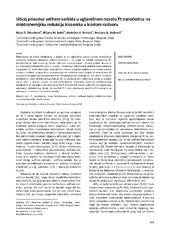Приказ основних података о документу
Effect of Tungsten Carbide in Carbon Pt Catalyst Support on Electrochemical Oxygen Reduction in Acid Solution
| dc.creator | Obradović, Maja D. | |
| dc.creator | Babić, Biljana M. | |
| dc.creator | Krstajic, Nedeljko V. | |
| dc.creator | Gojković, Snežana Lj. | |
| dc.date.accessioned | 2018-03-01T23:34:26Z | |
| dc.date.available | 2018-03-01T23:34:26Z | |
| dc.date.issued | 2013 | |
| dc.identifier.issn | 0367-598X | |
| dc.identifier.uri | https://vinar.vin.bg.ac.rs/handle/123456789/5600 | |
| dc.description.abstract | Tungsten carbide was synthesized by calcination of carbon cryogel with embedded tungsten in a form of metatungstate. This material was used as a support for Pt nanoparticles. XRD pattern of W-C support indicated the presence of WC, W2C, and unreacted W, as well as graphitized carbon. According to previous TEM analysis of W-C support, it contains particles with core-shell structure, where the W particle was covered with the shell of a mixture of WC and W2C. The average Pt grain size calculated from XRD pattern was about 6 nm. A cyclic voltammogram of W-C support was recorded within the potential range relevant for its application as a catalyst support in fuel cells. The pair of anodic/cathodic peaks close to the negative potential limit could be ascribed to the intercalation of hydrogen within hydrous tungsten oxide, which is always present on the surface of WC in aqueous solutions. The cyclic voltammogram of Pt/W-C indicated that tungsten oxide species are present on tungsten carbide shell as well as on the surface of Pt nanoparticles. The Pt surface is only partially covered by hydrous tungsten oxide. Hydrogen intercalation in hydrous tungsten oxide is enhanced in the presence of Pt nanoparticles. Also, the presence of hydrated tungsten oxide leads to the decrease of OH chemisorbed on Pt surface. Stripping of underpotentially deposited copper was used for the assessment of Pt surface area and the specific surface area of Pt was estimated to be 41 m(2) g(-1). The electrochemical oxygen reduction reaction was examined on the synthesized Pt/W-C catalyst and compared with the results on the commercial Pt/C catalyst. It was found that the current densities at Pt/W-C were almost twice as high as those on Pt/C. The Tafel plots for both catalysts are characterized with two Tafel slopes: -0.060 V dec(-1) at low current densities, and -0.120 V dec(-1) at high current densities. From the rotational dependence of the reaction rate, it was found that oxygen reduction on both Pt/W-C and Pt/C follows the first order kinetics with respect to O-2 and that four electrons are transferred per O-2 molecule. The results show that the presence of tungsten carbide in support material, i.e. hydrous tungsten oxide on Pt surface, leads to promotion of oxygen reduction on the Pt/W-C catalyst. It was assumed that oxophilic hydrated tungsten oxide hinders OH adsorption on Pt surface, thus increasing Pt surface area available for O-2 adsorption and its electrochemical reduction. | en |
| dc.relation | info:eu-repo/grantAgreement/MESTD/Basic Research (BR or ON)/172054/RS// | |
| dc.rights | openAccess | en |
| dc.source | Hemijska industrija | en |
| dc.subject | Pt nanoparticle | en |
| dc.subject | Catalyst support | en |
| dc.subject | Tungsten | en |
| dc.subject | Tungsten carbide | en |
| dc.subject | Electrochemical oxygen reduction | en |
| dc.subject | Acid solution | en |
| dc.title | Effect of Tungsten Carbide in Carbon Pt Catalyst Support on Electrochemical Oxygen Reduction in Acid Solution | en |
| dc.type | article | en |
| dcterms.abstract | Бабиц, Биљана М.; Крстајиц, Недељко В.; Гојковиц, Снезана Љ.; Обрадовиц, Маја Д.; | |
| dc.citation.volume | 67 | |
| dc.citation.issue | 2 | |
| dc.citation.spage | 303 | |
| dc.citation.epage | 311 | |
| dc.identifier.wos | 000322208200013 | |
| dc.identifier.doi | 10.2298/HEMIND120307063O | |
| dc.citation.rank | M23 | |
| dc.identifier.scopus | 2-s2.0-84877707706 | |
| dc.identifier.fulltext | https://vinar.vin.bg.ac.rs//bitstream/id/13467/5596.pdf |

